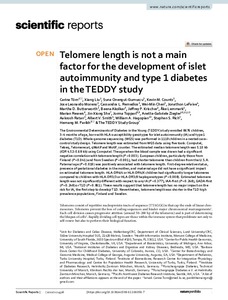Telomere length is not a main factor for the development of islet autoimmunity and type 1 diabetes in the TEDDY study
Törn Carina; Liu Xiang; Onengut-Gumuscu Suna; Counts Kevin M; Moreno Jose Leonardo; Remedios Cassandra L; Chen Wei-Min; LeFaive Jonathon; Butterworth Martha D; Akolkar Beena; Krischer Jeffrey P; Lernmark Åke; Rewers Marian; She Jin-Xiong; Toppari Jorma; Ziegler Anette-Gabriele; Ratan Aakrosh; Smith Albert V; Hagopian William A; Rich Stephen S; Parikh Hemang M; TEDDY Study Group
https://urn.fi/URN:NBN:fi-fe2022081154336
Tiivistelmä
The Environmental Determinants of Diabetes in the Young (TEDDY) study enrolled 8676 children, 3-4 months of age, born with HLA-susceptibility genotypes for islet autoimmunity (IA) and type 1 diabetes (T1D). Whole-genome sequencing (WGS) was performed in 1119 children in a nested case-control study design. Telomere length was estimated from WGS data using five tools: Computel, Telseq, Telomerecat, qMotif and Motif_counter. The estimated median telomere length was 5.10 kb (IQR 4.52-5.68 kb) using Computel. The age when the blood sample was drawn had a significant negative correlation with telomere length (P = 0.003). European children, particularly those from Finland (P = 0.041) and from Sweden (P = 0.001), had shorter telomeres than children from the U.S.A. Paternal age (P = 0.019) was positively associated with telomere length. First-degree relative status, presence of gestational diabetes in the mother, and maternal age did not have a significant impact on estimated telomere length. HLA-DR4/4 or HLA-DR4/X children had significantly longer telomeres compared to children with HLA-DR3/3 or HLA-DR3/9 haplogenotypes (P = 0.008). Estimated telomere length was not significantly different with respect to any IA (P = 0.377), IAA-first (P = 0.248), GADA-first (P = 0.248) or T1D (P = 0.861). These results suggest that telomere length has no major impact on the risk for IA, the first step to develop T1D. Nevertheless, telomere length was shorter in the T1D high prevalence populations, Finland and Sweden.
Kokoelmat
- Rinnakkaistallenteet [27094]
